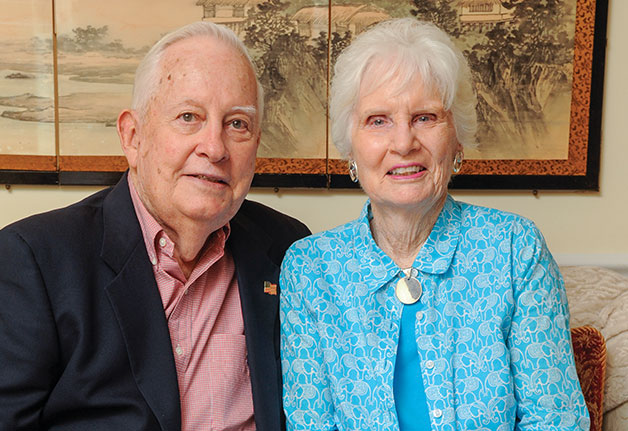After assassinating the Rev. Martin Luther King Jr. on April 4, 1968, in Memphis, Tenn., James Earl Ray escaped and led the world on a two-month manhunt. Scotland Yard captured him in London, and a month later, Col. Frank Pusey ’54 brought Ray back to Memphis.
It was July 1968, and Frank was stationed at Andrews Air Force Base just outside of Washington, D.C. He and his wife, Sarah, had tickets to see “Man of La Mancha” at the Kennedy Center. They were getting ready for the evening when the phone rang — not an unusual occurrence for pilots who flew in the 1254th Military Air Transport Wing, the squadron that flew the president as well as high-ranking U.S. government officials and designated foreign dignitaries.
"They said they needed me to take a flight, but they couldn’t tell me where I was going or what I was supposed to do. They just told me to go to the runway and look for a certain tail number,” says Frank. “I asked when I’d be coming back, but they couldn’t tell me. ‘OK,’ I said, ‘I’ll tell Sarah the good news.’”
While Sarah called their host for the evening with regrets, Frank met the crew along with a contingent of FBI agents. There he learned he was flying to London for Ray’s extradition.
“The FBI considered him capable of anything. They wanted us to know that. I said, ‘Just don’t let him through that door (referring to the door to the cockpit), and we’ll be OK.’” says Frank.
Frank’s 27-year distinguished career with the Air Force also included flying Lyndon Johnson, Gerald Ford, Richard Nixon and Ronald Reagan, although not all were presidents at the time. He safely guided the Apollo 11 astronauts, Buzz Aldrin, Neil Armstrong and Michael Collins, through the last half of their goodwill tour following their successful moon landing, and he flew Shirley Temple Black, Spiro Agnew and a host of others on diplomatic missions. The stories are many, and Frank and Sarah exchange glances and smile with the retelling.
“Sarah made me promise not to use profanity,” says Frank after he almost slips during the interview. “Once you get to be 85, the line between stories I’ve lived and stories I’ve heard blur, but at least you’ll know they’re somebody’s war stories.”
Sarah shakes her head and remains on her toes, interjecting details, to keep Frank “honest,” something you can tell she’s been doing her whole life. After all, he followed her to Spartanburg, choosing Wofford because of its proximity to Converse College. Frank went on to pitch for the Terriers, participate in the Army ROTC program and make good friends, including Dr. John Liston ’54 and roommate George Perrow ’54, now deceased.
“Wofford was a good entrée,” says Frank. “I got an education and a degree, and I got to be with my girlfriend, not necessarily in that order.”
Frank has flown largely under the radar because many of his missions were classified. After 30 years, however, it’s now safe to tell some of the remarkable stories.
“I stood by in San Clemente with Nixon and flew Johnson back and forth to his ranch in Texas. He loved showing people his cattle. We got first-rate treatment, and the job had its perks, like getting to play golf on Bob Hope’s Palm Beach estate,” says Frank.
He flew Johnson out to Nixon’s birthday party and joined family and friends for cake. He toured Calumet horse farm in Lexington, Ky., with Pat Nixon and enjoyed dinner in Bangkok, Thailand, with Nancy and Ronald Reagan. One of his greatest regrets is not taking photos.
“I went to so many places and did so many things, but a pilot carrying a camera was considered bourgeois,” says Frank. “Now I regret that I didn’t have one with me.” Frank says he often thought about asking for autographs, but that was frowned upon as well. He may not have original photos and signatures, but Sarah was back home clipping newspaper stories about her husband’s adventures. They now have an impressive collection of scrapbooks.
“Johnson loved root beer. He would drink a six-pack before the plane got to the Mississippi River. Once he ran out near Lambert Field in St. Louis,” says Frank. Johnson ordered an unplanned stop to pick up enough to get through the remainder of the trip. Johnson also often complained about the temperature on the planes. “The crew of Air Force One arranged for him to have his own personal thermostat with a toggle switch. He could switch it to cool and a green light would come on. Then he could switch it to red for heat. The switch didn’t connect to anything, but it solved the problem.”
Prior to flying with the 1254th, Frank flew single-engine fighters before switching to the Douglas C-124 Globemaster, nicknamed “Old Shaky.” The move to transport planes brought him back near home and Charleston AFB. Frank flew the huge C-130 Hercules cargo planes in Vietnam.
“Flying cargo jets meant hours of boredom interspersed with moments of stark terror,” he says.
Frank had almost 10,000 flying hours — a year and a half in the cockpit — when he retired. He was grounded for only one year during his career while serving as deputy commander at Andrews AFB. He earned a master’s degree through the Air Force and after military service enjoyed a second career in real estate.
“I loved flying, but I had been away enough,” he says.
Now Frank and Sarah split their time between homes in Summerville, S.C., and DeBordieu, near their hometown of Georgetown, S.C. They enjoy golf, sharing stories and planning new adventures with their four children, eight grandchildren and two great-grands.
By Jo Ann Mitchell Brasington ’89
